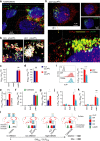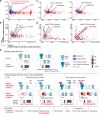Synergy between B cell receptor/antigen uptake and MHCII peptide editing relies on HLA-DO tuning
- PMID: 31554902
- PMCID: PMC6761166
- DOI: 10.1038/s41598-019-50455-y
Synergy between B cell receptor/antigen uptake and MHCII peptide editing relies on HLA-DO tuning
Abstract
B cell receptors and surface-displayed peptide/MHCII complexes constitute two key components of the B-cell machinery to sense signals and communicate with other cell types during antigen-triggered activation. However, critical pathways synergizing antigen-BCR interaction and antigenic peptide-MHCII presentation remain elusive. Here, we report the discovery of factors involved in establishing such synergy. We applied a single-cell measure coupled with super-resolution microscopy to investigate the integrated function of two lysosomal regulators for peptide loading, HLA-DM and HLA-DO. In model cell lines and human tonsillar B cells, we found that tunable DM/DO stoichiometry governs DMfree activity for exchange of placeholder CLIP peptides with high affinity MHCII ligands. Compared to their naïve counterparts, memory B cells with less DMfree concentrate a higher proportion of CLIP/MHCII in lysosomal compartments. Upon activation mediated by high affinity BCR, DO tuning is synchronized with antigen internalization and rapidly potentiates DMfree activity to optimize antigen presentation for T-cell recruitment.
Conflict of interest statement
The authors declare no competing interests.
Figures






Similar articles
-
DM and DO shape the repertoire of peptide-MHC-class-II complexes.Curr Opin Immunol. 2005 Feb;17(1):65-70. doi: 10.1016/j.coi.2004.11.003. Curr Opin Immunol. 2005. PMID: 15653313 Review.
-
Downmodulation of antigen presentation by H2-O in B cell lines and primary B lymphocytes.Eur J Immunol. 2003 Feb;33(2):411-21. doi: 10.1002/immu.200310015. Eur J Immunol. 2003. PMID: 12645938
-
Modulation of the major histocompatibility complex class II-associated peptide repertoire by human histocompatibility leukocyte antigen (HLA)-DO.J Exp Med. 2000 Apr 3;191(7):1127-36. doi: 10.1084/jem.191.7.1127. J Exp Med. 2000. PMID: 10748231 Free PMC article.
-
The role of H2-O and HLA-DO in major histocompatibility complex class II-restricted antigen processing and presentation.Immunol Rev. 1999 Dec;172:255-66. doi: 10.1111/j.1600-065x.1999.tb01370.x. Immunol Rev. 1999. PMID: 10631951 Review.
-
B cells rapidly target antigen and surface-derived MHCII into peripheral degradative compartments.J Cell Sci. 2019 Dec 20;133(5):jcs235192. doi: 10.1242/jcs.235192. J Cell Sci. 2019. PMID: 31780582
Cited by
-
Prognostic significance of myeloid immune cells and their spatial distribution in the colorectal cancer microenvironment.J Immunother Cancer. 2021 Apr;9(4):e002297. doi: 10.1136/jitc-2020-002297. J Immunother Cancer. 2021. PMID: 33931472 Free PMC article.
-
Nanomedicines in B cell-targeting therapies.Acta Biomater. 2022 Jan 1;137:1-19. doi: 10.1016/j.actbio.2021.10.024. Epub 2021 Oct 21. Acta Biomater. 2022. PMID: 34687954 Free PMC article. Review.
-
The lysosomal trafficking regulator "LYST": an 80-year traffic jam.Front Immunol. 2024 May 7;15:1404846. doi: 10.3389/fimmu.2024.1404846. eCollection 2024. Front Immunol. 2024. PMID: 38774881 Free PMC article. Review.
-
TCR-like antibodies targeting autoantigen-mhc complexes: a mini-review.Front Immunol. 2022 Jul 27;13:968432. doi: 10.3389/fimmu.2022.968432. eCollection 2022. Front Immunol. 2022. PMID: 35967436 Free PMC article. Review.
-
Proper development of long-lived memory CD4 T cells requires HLA-DO function.Front Immunol. 2023 Oct 16;14:1277609. doi: 10.3389/fimmu.2023.1277609. eCollection 2023. Front Immunol. 2023. PMID: 37908352 Free PMC article.
References
Publication types
MeSH terms
Substances
Grants and funding
LinkOut - more resources
Full Text Sources
Research Materials

